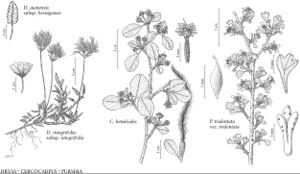Purshia
in J. Lamarck et al., Encycl., Suppl. 4: 623. 1816.
Shrubs, 2–75 dm. Stems 3–20+, branched; bark cinnamon brown, weathering gray, in thin papery sheets; short-shoots present. Leaves persistent or drought-deciduous, abscising distal to bases, crowded on short-shoot spurs, simple; stipules persistent, deltate, margins entire; petiole usually absent, sometimes present; blade linear or ovate to obovate, 0.3–1.5 (–1.9) cm, coriaceous, sometimes thin, margins revolute, entire or toothed to lobed, abaxial surface usually densely hairy, adaxial glabrous or sparsely hairy. Inflorescences terminal on short-shoots, flowers solitary; bracts present resembling immature leaves; bracteoles absent. Pedicels present. Flowers 10–15 (–25) mm diam.; hypanthium obconic, sometimes hemispheric in fruit, 2.5–6.5 mm, exterior villous, stipitate-glandular or not, interior glabrous, nectariferous; sepals 5, spreading-reflexed, ovate to oblong-ovate, abaxial surface pubescent-villous; petals 5, caducous, white, cream-yellow, or yellow [rose red], broadly obovate or obovate-spatulate to spatulate, base cuneate to clawed, apex spreading, rounded to emarginate; stamens (17–) 20–80 (–125), shorter than petals; torus absent; carpels 1–15 (–31), stipitate, stigmas terminal. Fruits achenes, 1, obovoid-fusiform or oblanceoloid, 4–12 mm, leathery; hypanthium persistent; sepals persistent, spreading-reflexing. x = 9.
Distribution
sw United States, n Mexico
Discussion
Species 6 (4 in the flora).
This treatment combines Cowania (with 3–31 carpels that develop into wind-dispersed achenes with plumose awns) with Purshia (with 1–3 carpels that form into larger, leathery achenes with persistent style bases that are often dispersed by rodents that cache the fruits for later use). This is supported by the presence of intergeneric hybrids, by the similar vegetative and floral morphologies, except for carpel number and means of fruit dispersal, and by molecular data. The roots are often associated with the nitrogen-fixing actinomycete Frankia. Some species are important browse for ungulates.
Selected References
None.
Key
| 1 | Carpels 1 or 2; achenes broadly obovoid-fusiform, 3.5–5.2 mm diam., persistent style 5–7(–10) mm, densely hirtellous. | Purshia tridentata |
| 1 | Carpels (2–)5–15(–31); achenes oblanceoloid, 1.1–2.5 mm diam., persistent style (15–)20–59 mm, plumose | > 2 |
| 2 | Leaf blades oblong to spatulate, margins irregularly lobed, lobes (3–)5(–7). | Purshia stansburyana |
| 2 | Leaf blades linear to oblanceolate or linear-subulate, margins entire or with 1–2 teeth or lobes | > 3 |
| 3 | Leaf blades: margins revolute (not obscuring abaxial surfaces), entire or with 1–2 teeth or lobes; petals light yellowish cream; stamens (28–)34–54; carpels (2–)4–5(–6). | Purshia subintegra |
| 3 | Leaf blades: margins strongly revolute (nearly obscuring abaxial surfaces), entire; petals white or suffused with red; stamens (60–)80–120; carpels (12–)17–31. | Purshia ericifolia |
"thin" is not a number.
